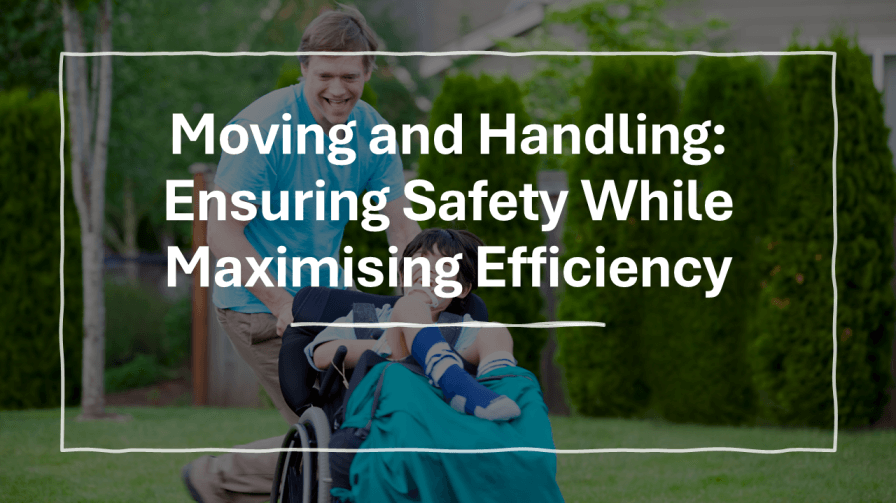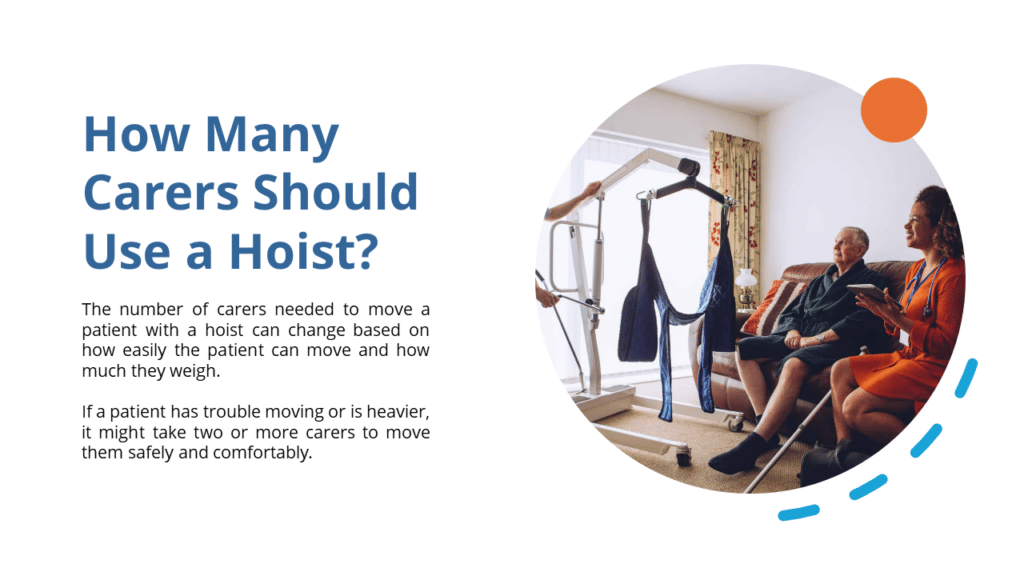Hoist Training for Carers: Ensuring Safe and Efficient Patient Transfers
Estimated reading time: 9 minutes
In 2021, a request for information from the Office for National Statistics showed that many incidents related to hoists happen each year, causing injuries to both patients and staff.
Hoists, also called patient lifts, are crucial for helping people with limited mobility.
But for carers to use them safely and effectively, they need special training.
This guide covers important parts of hoist training, helping carers feel confident and safe when using hoists. It answers key questions like:
- What training do you need to use a hoist?
- Do you need two carers to use a hoist?
- What are the essential safety checks before using a hoist?
- How often should hoists be checked?
As a carer, one of your main jobs is to help patients move safely and comfortably when they need help getting around.
Hoists are really helpful for this but using them right means getting good training to avoid accidents and injuries.
By making safety a priority, using the right methods, and following the best practices, carers can make transfers comfortable and positive for their patients.
This guide gives you the information you need to help create a safer healthcare setting for everyone.
Interested in
Hoist Training?
Face to Face training by our trained experts.

What is hoist training?
Hoist training is all about teaching caregivers, nurses, and healthcare workers how to use patient hoists or lifts correctly.
These hoist devices help move people with limited mobility safely and comfortably, like those who can’t get out of bed or a wheelchair easily.
The main goals of hoist training are to make sure:
- Safety: Avoid injuries to patients and caregivers during transfers.
- Proper moving people techniques: Learn the right ways to use hoists, position slings, and move patients.
- Understanding equipment: Know about different hoists, how much weight they can handle, and what kinds of slings they need.
- Checking and maintaining: Learn how to do pre-use checks, regular inspections, and maintenance for hoists and slings.
- Following rules: Stick to the rules and guidelines about handling patients and using equipment, as well as any facility policies.
What Training Do You Need to Use a Hoist?
Moving and Handling (Manual Handling) training with a specific focus on hoists is mandatory for carers who will be using them.
This training equips carers with the knowledge and skills necessary for safe and efficient hoist operation.
It covers topics like:
- Risk assessment: Identifying possible risks linked with hoist use and applying proper control measures.
- Safe sling selection and application: Choosing the correct sling type for each patient and ensuring proper use for best support.
- Hoist operation: Understanding the mechanics of the hoist, its functions, and safe operating procedures.
- Patient positioning and transfer techniques: Safely transferring patients using the hoist while maintaining their comfort and dignity.
- Post-transfer care: Ensuring proper positioning and comfort after the transfer is complete.
Do You Need Two Carers to Use a Hoist?
The number of carers required to operate a hoist depends on the patient’s weight, mobility level, and specific transfer situation.
In some cases, a single carer with proper training and experience can manage a hoist transfer for patients with minimal assistance needs.
However, for heavier patients, those requiring significant assistance during transfer, or in situations with a higher risk of falls, two carers are generally recommended.
This ensures patient safety and minimises the risk of injury to the carer.
People Also Read: Learn how to lift heavy patients with right moving tools
What Must You Never Do When Using a Hoist?
When using a hoist, there are several crucial things you must never do:
- Never attempt to transfer a patient without proper training and supervision.
- Never leave a patient unattended while in the hoist or sling.
- Do not attempt to lift a patient who is not properly secured in the sling.
- Never exceed the hoist’s weight capacity or lift a patient improperly.
- Do not use a hoist for a purpose it is not designed for, such as lifting furniture.
- Never use a damaged or malfunctioning hoist or sling.
- Do not lift a patient higher than necessary.
What Are the Three Main Areas You Must Check Before Using a Hoist?
Before operating a hoist, carers must conduct a thorough check of three main areas:
- Patient assessment: Evaluate the patient’s mobility, weight, and any specific needs or risks.
- Hoist inspection: Ensure the hoist is in proper working condition, with no signs of damage or wear.
- Environment check: Clear the transfer area of any obstacles, ensure adequate space, and check for potential hazards.

Pre-Transfer Hoist Checks: The Big Three
Before using a hoist, it’s crucial to conduct thorough checks to ensure its safe operation. These checks focus on three key areas:
- The hoist itself: Inspecting for visible damage, fluid leaks, and proper functionality of controls.
- The sling: Checking for wear and tear, fraying, or any damage that could compromise patient safety.
- The environment: Ensuring the transfer area is clear of obstacles and has enough space for safe maneuvering of the hoist.
- Load Check: This is an important check to make sure the hoist can safely lift the patient’s weight. The test might be done differently depending on the hoist, but usually, a special weight that matches or is heavier than the patient is used. Check the instructions from the hoist’s maker for the right way to do the test.
Going Beyond: The Six Hoist Checks
Many healthcare organizations implement a six-point (some say five-checks) hoist check for added safety.
This includes the four points mentioned above, along with:
- Battery level: Confirming sufficient battery power for the hoist operation.
- Emergency stop: Verifying that the emergency stop function is working correctly.
The five essential hoist checks include:
1. Visual inspection
Check for any visible signs of damage, wear, or missing components.
2. Sling inspection
Ensure the sling is compatible with the hoist, properly sized, and free from tears or frays.
3. Battery check
Verify the battery is fully charged and operational. Check this from time to time.
4. Load test
Conduct a brief load test with no weight to check for proper functioning.
5. Emergency stop
Test the emergency stop hoist button to ensure it works correctly. Check before lifting people.
What Are the Common Five Hoist Checks?
The five essential hoist checks include:
- Visual inspection: Check for any visible signs of damage, wear, or missing components.
- Sling inspection: Ensure the sling is compatible with the hoist, properly sized, and free from tears or frays.
- Battery check: Verify the battery is fully charged and operational.
- Load test: Conduct a brief load test with no weight to check for proper functioning.
- Emergency stop: Test the emergency stop button to ensure it works correctly.
Related Course: Get Your In-House Team Trained To Train Others in Moving Patient Safely.
How Many Times Should a Hoist Be Checked?
Hoists should be checked before each use to ensure they are in proper working condition and safe for patient transfers.
Daily pre-use checks are a must for every hoist. Additionally, thorough inspections by a qualified engineer should be conducted at regular intervals as specified by the manufacturer’s guidelines (typically every 6-12 months).
How Often Do You Need to Check the Hoist?
In addition to pre-use checks, hoists should undergo regular inspections and maintenance checks.
The frequency of these checks may vary depending on the manufacturer’s guidelines, but a common recommendation is to perform a thorough inspection every six months or annually.
How Many Carers Should Use a Hoist?
As mention earlier, it’s usually better to have two carers when using hoists.
But how many carers you need can change depending on:
- how heavy the patient is,
- how well they can move, and
- how the transfer is happening.
Places should have clear rules and training on how to decide how many carers are needed for using hoists safely.

How Many Carers Do You Need to Transfer to a Hoist?
The number of carers needed to move a patient with a hoist can change based on how easily the patient can move and how much they weigh.
If a patient has trouble moving or is heavier, it might take two or more carers to move them safely and comfortably.
Places where hoists are used should teach the right ways to move patients and when extra help is needed.
Before using a hoist, it is important to check a few things about the patient:
- How much the patient weighs and if they can help with the transfer.
- Their medical history and any risks related to using the hoist.
- Choosing the right sling to give them the best support.
How Long Should a Hoist Be Inspected?
Hoists should undergo thorough inspections at regular intervals, typically every six months or annually, as per the manufacturer’s recommendations or facility protocols.
These inspections should be conducted by trained personnel or authorized service providers to ensure the hoist’s safety and proper functioning.
How Do You Assess a Hoist?
Assessing a hoist involves a complete evaluation of its condition and functionality. This includes:
- Visual inspection: Checking for signs of wear, damage, or missing components.
- Operational testing: Verifying the hoist’s movements, brakes, and emergency stop function properly.
- Load testing: Applying a known weight to test the hoist’s lifting capacity and stability.
- Sling compatibility: Ensuring the sling is compatible with the hoist and in good condition.
- Documentation review: Checking maintenance records and manufacturer guidelines.
Can You Leave a Hoist Sling Under a Patient?
It is usually best not to keep a hoist sling under a patient for too long.
After each transfer, it is important to take the sling off to avoid skin problems, discomfort, and hygiene issues.
However, in some cases, like if there are lots of transfers or if healthcare workers think it is necessary, the sling might stay under the patient for a short while under careful watch.
Related Course: Evacuation Chair Training With 3 year Certificate Validity
Frequently Asked
Why do carers need training for using hoists with cerebral palsy patients?
Carers need special hoist training for cerebral palsy patients because:
Safety: Cerebral palsy patients have unique mobility challenges, so proper hoist use prevents injuries to both patient and carer.
Comfort: Training ensures patients are positioned comfortably and with dignity.
Equipment: Cerebral palsy often needs custom hoists/slings, so training covers how to use them correctly.
Injury Prevention: Training teaches safe lifting and teamwork to avoid injuries.
Communication: Some patients can’t speak, so carers learn to understand non-verbal cues for better transfers.
Personalised Care: Each patient is different, so training focuses on assessing their needs for individualized transfers.
Compliance: Facilities have rules on equipment use, so training ensures carers follow them and reduce risks.
Skill Maintenance: Regular refreshers keep carers up-to-date with changing patient needs.
In simple terms, this training helps carers safely and comfortably transfer cerebral palsy patients while providing individualised, respectful care and following the rules.
Conclusion
It is important for carers to learn how to use hoists properly so they can move patients safely.
They need to know the right way to do things and follow safety rules.
Doing regular training, following safety steps, and checking the equipment carefully are all important for keeping patients safe when using hoists.
Let us Help you
We’ll help you find the right course for your needs. Tell us a little bit about your situation and what you would like to achieve.
We’ll get back to you within one working day.
